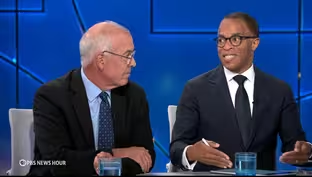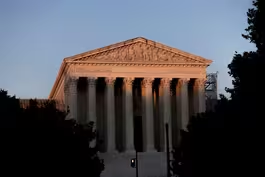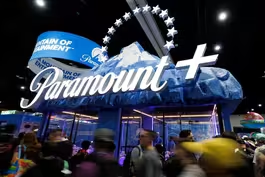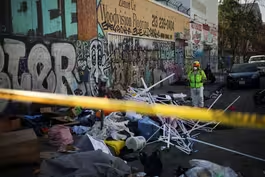
Ruth Asawa exhibit celebrates her influential art and life
Clip: 7/25/2025 | 7m 42sVideo has Closed Captions
Ruth Asawa exhibition celebrates her influential art and extraordinary life
The work of artist Ruth Asawa, who died in 2013, is back in the spotlight with a major traveling exhibition. It’s a celebration of not only her work, but also an extraordinary life. Senior arts correspondent Jeffrey Brown reports for our arts and culture series, CANVAS.
Problems playing video? | Closed Captioning Feedback
Problems playing video? | Closed Captioning Feedback
Major corporate funding for the PBS News Hour is provided by BDO, BNSF, Consumer Cellular, American Cruise Lines, and Raymond James. Funding for the PBS NewsHour Weekend is provided by...

Ruth Asawa exhibit celebrates her influential art and life
Clip: 7/25/2025 | 7m 42sVideo has Closed Captions
The work of artist Ruth Asawa, who died in 2013, is back in the spotlight with a major traveling exhibition. It’s a celebration of not only her work, but also an extraordinary life. Senior arts correspondent Jeffrey Brown reports for our arts and culture series, CANVAS.
Problems playing video? | Closed Captioning Feedback
How to Watch PBS News Hour
PBS News Hour is available to stream on pbs.org and the free PBS App, available on iPhone, Apple TV, Android TV, Android smartphones, Amazon Fire TV, Amazon Fire Tablet, Roku, Samsung Smart TV, and Vizio.
Providing Support for PBS.org
Learn Moreabout PBS online sponsorshipGEOFF BENNETT: The work of artist Ruth Asawa, who died in 2013, is back in the spotlight with a major traveling exhibition now in San Francisco.
It's a celebration of her work, but also her extraordinary life.
Senior arts correspondent Jeffrey Brown reports for our arts and culture series, Canvas.
JEFFREY BROWN: They are large looped wire sculptures hanging from the ceiling.
They can look like human bodies or shapes from nature.
And grouped together, they play off one another through shadows and light.
The works of Ruth Asawa come in many sizes and also many forms, including paintings and drawings, clay masks and bronze sculptures of hands and feet.
JANET BISHOP, Curator, San Francisco Museum of Modern Art: Really, anything could be a viable material for art for Asawa.
JEFFREY BROWN: What does that tell you about her, I mean, as an artist, as a creative person?
JANET BISHOP: That she was incredibly open.
She had a very open, experimental, kind of expansive vision of what art could be.
JEFFREY BROWN: Janet Bishop is co-curator of Ruth Asawa: Retrospective, now at SFMOMA, the San Francisco Museum of Modern Art, more than 300 works from the 1940s into the 2000s.
JANET BISHOP: To me, she is absolutely one of the most accomplished artists of the 20th century.
JEFFREY BROWN: There's even an installation evoking the living room of the San Francisco home where Asawa worked and where she and husband Albert Lanier raised six children.
One of them, Paul Lanier, himself an artist, lives there today and recalls his mother constantly making and playing with materials and forms.
PAUL LANIER, Son of Ruth Asawa: She would love that word, to play.
And so she... JEFFREY BROWN: She did like that.
She used that word?
PAUL LANIER: Yes, she would say play and experiment with the work.
And maybe, if one piece came out really great, she wouldn't copy it and do it again, but she would learn from it and then make -- try something else to learn from one shape and take it into the next shape that she was doing.
JEFFREY BROWN: The child of Japanese immigrant farmers, Ruth Asawa was born in 1926 and grew up in Southern California.
And she herself helped with the work from an early age.
NARRATOR: Well, you see the extent of the damage in these authentic pictures.
JEFFREY BROWN: Soon after the Japanese attacked Pearl Harbor and the U.S. entered World War II, her father was arrested and the rest of the family -- Ruth herself was aged 16 -- sent to an internment or incarceration camps, first in California, then in Arkansas.
After 16 months, she was allowed to attend college in Milwaukee and hoped to become an art teacher, but racial discrimination prevented that.
Instead, another life-changing turn, as friends encouraged her to enroll at Black Mountain College in North Carolina, a renowned progressive and experimental institution that nurtured many famous artists.
RUTH ASAWA, Artist: When he said, well, I'm the most successful figure.
JEFFREY BROWN: Asawa studied with and befriended such figures as Josef Albers and Buckminster Fuller.
In a 1978 short film, "Of Forms and Growth," Asawa described what she learned from Albers about understanding and working with specific materials.
RUTH ASAWA: What he was talking about was abstracting from the material.
Rather than being concerned with your own design ideas and forcing something into it, what you do is, you become background, just like a parent allows the child to express himself and the parent becomes sort of supportive.
JEFFREY BROWN: It was on a trip to Mexico that Asawa saw craftspeople making wire baskets.
She would first make her own and then explode them out into the large sculptures for which she became best known.
PAUL LANIER: I think, when she made those first pieces, just a lightbulb went off, and she recognized there was something special here, and then later on the world has discovered how special these pieces are.
JEFFREY BROWN: In fact, there was early recognition, with gallery shows in New York and inclusion in museum exhibitions in the 1950s.
But Asawa seems to have pulled back, doing things her own way, as she and Lanier, an architect she'd met at Black Mountain, committed to living and raising their family in San Francisco.
HENRY WEVERKA, President, Ruth Asawa Lanier, Inc.: When I was a kid, it was just always interesting to go over my grandmother's house to see what was going on.
And it was either drawing, painting, folding paper, making dill pickles, squeezing orange juice, whatever it was.
There was always something being made.
JEFFREY BROWN: Henry Weverka, one of Asawa's 10 grandchildren and head of the family business handling her artworks, showed us another aspect of Asawa's artistic life, the public sculpture she created in and around San Francisco, including this one in Ghirardelli Square, so different from her more abstract work.
Weverka says his grandmother loved making something for families and children to enjoy, even if the people who commissioned it were at first unhappy.
They weren't expecting two mermaids, one of them nursing.
HENRY WEVERKA: So much so that it was actually installed in the middle of the night.
We had an amazing photograph of my grandmother standing on one of these turtles popping a bottle of champagne when it was finally installed.
JEFFREY BROWN: You mean sneaking it in?
HENRY WEVERKA: Essentially sneaking it in, in the middle of the night, yes.
NARRATOR: From these materials, she made the molds for casting the fountain.
JEFFREY BROWN: Asawa was also a passionate advocate for arts education in public schools, helping start a local organization that brought professional artists into the schools to work with young students and a public high school for the arts that now bears her name.
HENRY WEVERKA: What really I admire most about my grandmother is her ability to get to work, find like-minded people to work towards a shared goal.
And, in this case, it was expanding art education programming in San Francisco Public Schools.
JEFFREY BROWN: Asawa directly addressed her World War II experience in a 1990 public commission for a Japanese-American internment memorial in San Jose, showing the farmwork, the arrests, life in the camps.
Her son Paul worked on it with her, but, for the most part, he says, his mother didn't speak of her incarceration.
PAUL LANIER: She would talk about life on the farm, but, no, she did not talk about the internment at all.
JEFFREY BROWN: Does that surprise you?
PAUL LANIER: I think it's kind of a Japanese thing to not talk about such unpleasant things.
Yes, you get on with it.
JEFFREY BROWN: You get on with it.
PAUL LANIER: Yes.
JEFFREY BROWN: In 1985, Ruth Asawa was diagnosed with lupus, which eventually limited her energy, while also rekindling her love of painting.
The final galleries in the exhibition featured drawings and watercolors of flowers and plants.
JANET BISHOP: I have been hoping that people would be inspired not only by the art itself, which is truly remarkable, but how she lived her life, how important it was to her to shape the world she wanted to see.
JEFFREY BROWN: Asawa died in 2013 at age 87, and it's only since then that she's reached a much wider recognition, including a posthumous National Medal of Arts given by President Joe Biden, her own postage stamp in 2020, and now this retrospective that moves to New York's Museum of Modern Art in the fall, and next year to the Guggenheim Museum Bilbao in Spain.
For the "PBS News Hour," I'm Jeffrey Brown in San Francisco.
Brooks and Capehart on the Epstein files and Trump's base
Video has Closed Captions
Clip: 7/25/2025 | 13m 37s | Brooks and Capehart on the Epstein files fracturing Trump's base (13m 37s)
How private companies could cash in on Trump's deportations
Video has Closed Captions
Clip: 7/25/2025 | 5m 48s | How private companies could cash in on Trump's mass deportations (5m 48s)
Kagan criticizes justices over lack of explanation
Video has Closed Captions
Clip: 7/25/2025 | 6m 46s | Kagan criticizes fellow justices over lack of explanation in recent Supreme Court rulings (6m 46s)
News Wrap: Israel considering alternatives to Gaza ceasefire
Video has Closed Captions
Clip: 7/25/2025 | 4m 53s | News Wrap: Israel considering 'alternative options' to ceasefire with Hamas (4m 53s)
The politics behind the $8B Paramount-Skydance merger
Video has Closed Captions
Clip: 7/25/2025 | 7m 34s | The politics behind the $8B Paramount-Skydance merger (7m 34s)
What Trump's order on forced treatment means for unhoused
Video has Closed Captions
Clip: 7/25/2025 | 5m 53s | What Trump's order on clearing encampments, forced hospitalization means for the unhoused (5m 53s)
Providing Support for PBS.org
Learn Moreabout PBS online sponsorshipSupport for PBS provided by:
Major corporate funding for the PBS News Hour is provided by BDO, BNSF, Consumer Cellular, American Cruise Lines, and Raymond James. Funding for the PBS NewsHour Weekend is provided by...

















